First Intermediate Period of Egypt › Amenhotep III » Ancient origins
Articles and Definitions › Contents
- First Intermediate Period of Egypt › Antique Origins
- Amenhotep III › Who Was
Ancient civilizations › Historical and archaeological sites
First Intermediate Period of Egypt › Antique Origins
Definition and Origins
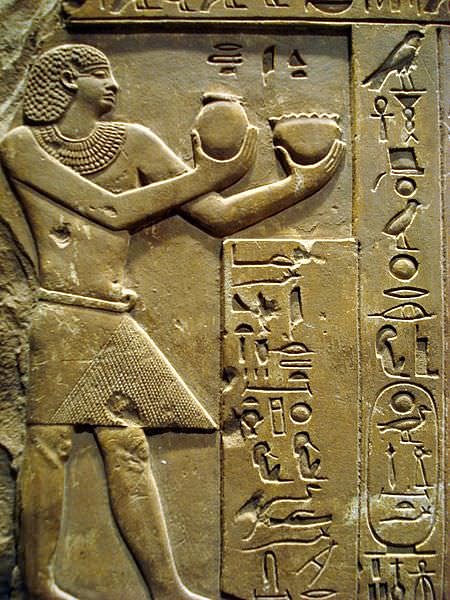
The First Intermediate Period of Egypt (2181-2040 BCE) is the era which followed the Old Kingdom (c. 2613-2181 BCE) and preceded the Middle Kingdom (2040-1782 BCE) periods of Egyptian history. The name was given to the era by 19th-century CE Egyptologists, not by the ancient Egyptians. Stable eras of Egyptian history are referred to as 'kingdoms' while eras of political strife or instability are known as 'intermediate periods.' This period has long been labeled a 'dark age' when the central government of the Old Kingdom, which had been built on the model of the Early Dynastic Period in Egypt (c. 3150-2613 BCE) collapsed and plunged the country into chaos. Recent scholarship has revised this opinion, and now the First Intermediate Period is seen as a time of change and transition, where the power and customs dictated by the monarchy at Memphis, capital of the Old Kingdom of Egypt, were disseminated throughout the country to those of traditionally lower status.
Probably the best way to understand the First Intermediate Period of Egypt is to consider modern retail capitalism and mass consumerism. In the mid-19th century CE (c. 1858) the American department store Macy's in New York City boasted that they sold "Goods suitable for the millionaire at prices in reach of the millions" (14th Street Tribune, 2). Prior to the Industrial Revolution and mass consumerism, certain goods were available only to the wealthy who had the disposable income to spend on such purchases. With the rise of department stores like Macy's, following the Industrial Revolution and mass production, these kinds of goods, though of lesser quality, were available to anyone at a much-reduced cost. This is precisely what happened during Egypt's First Intermediate Period. Those who previously could not afford elaborate homes, gardens, tombs, tomb inscriptions, or their own Pyramid Texts to guide them through the afterlife now found that they could because wealth was no longer only in the hands of the upper-class nobility. Whereas once only the king was provided with tomb inscriptions in the form of the Pyramid Texts, now nobility, officials, and ordinary people were also provided with a guide book to the underworld through the Coffin Texts.
This was possible because of the collapse of the central government at Memphis and the rise of individual nomarchs(governors or administrators of nomes, Egyptian districts) who finally held more power than the king of Egypt. Throughout the Old Kingdom's 4th Dynasty, a great amount of resources and manpower had gone into the construction of the pyramids and mortuary complexes at Giza, and as this site grew, so did the power of the priesthood who administered and cared for the site and others like it. Mortuary priests, especially those attached to the sun god Ra, began to amass more wealth than many nobles. The priests were powerful enough to influence the local officials, and as the priests gained more power so did the nomarchs. As individual nomes became more wealthy, more people could afford to purchase goods and services which had earlier been available only to the wealthy.
IT WAS A PERIOD OF CHANGE & TRANSITION, WHERE THE POWER AND CUSTOMS DICTATED BY THE MONARCHY AT MEMPHIS WERE DISSEMINATED THROUGHOUT THE COUNTRY TO THOSE OF TRADITIONALLY LOWER STATUS.
This rise of the priesthood, coupled with other factors such as the lack of a successor for the long-lived Pepi II and a severe drought, brought about the collapse of the political structure of the Old Kingdom and moved Egypt into the First Intermediate Period, but, again, this should not be seen as a 'dark age' or an age of chaos. It was a period of change for Egypt, and when that change was assimilated into the culture, the country emerged into the era of the Middle Kingdom and went on. The lack of reliable records, especially for the 7th and 8th Dynasties, contributes to the reputation of the era as a 'dark age' as does the quality of the art and architecture produced. Further, the lack of a strong central government - and the friction between Lower and Upper Egypt - has characterized this era as chaotic and lawless. Although the country lacked the unity it had maintained since the time of Narmer (also known as Menes, c. 3150 BCE), Egypt in the First Intermediate Period was far from the frenzied chaos traditionally assigned to it by later writers. This period ended with the rise of Mentuhotep II of Thebes (c. 2061-2010 BCE) who united the country under his rule and initiated the time known as the Middle Kingdom of Egypt.
THE NATURE OF THE FIRST INTERMEDIATE PERIOD
During the time of the Old Kingdom, the rulers diverted enormous resources into mortuary complexes such as that at Giza plateau with its famous pyramids. As these elaborate complexes became more numerous, they required more priests and functionaries to care for them. The primary necropolis of the Old Kingdom was at Giza, but there were also mortuary complexes at Saqqara and Abusir and elsewhere. The rulers of the Old Kingdom also delegated responsibility to the nomarchsand lesser administrators who carried out their duties in accordance with the king's wishes. As historian Marc van de Mieroop notes:
One man alone never held the all-encompassing powers of the center, even if the rhetoric of the Old Kingdom made the king the source of all authority. Kings needed officials to run the complex operations of the court and had always rewarded these people, including with gifts of burials and of mortuary cults that received provisions from estates set aside for the purpose. (86)
During the 5th Dynasty of the Old Kingdom, the king Djedkare Isesi (2414-2375 BCE) decentralized the government and delegated more responsibility to these nomarchs. At the same time, the resources of the royal treasury were enriching the priests at these mortuary complexes and the gifts of the king to nomarchs were further draining funds from the throne and enriching the provincial regions.
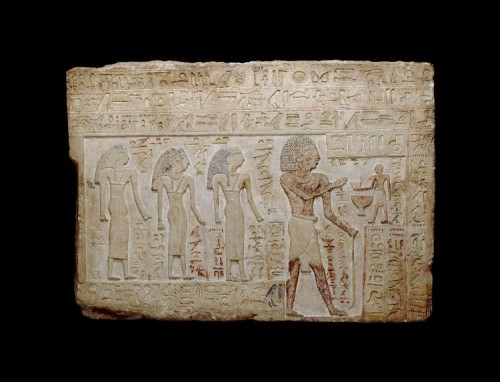
Intef
The First Intermediate Period, therefore, is chiefly characterized by an increase in the power of provincial administrators of separate regions and a decrease in that of the central government at Memphis. This shift in power is evident in every aspect of the archaeological and literary evidence. The great monuments of the Old Kingdom on the scale of the pyramids at Giza were no longer built in the First Intermediate Period because there was no powerful central ruler to commission and pay for them and no bureaucracy to organize the sizeable labor force. The lack of imposing monuments from this period, as well as the inferior quality of the artwork and a lack of historical records (the king's names and dates are either missing or confused for the 7th through the 10th Dynasties) encouraged early scholars of Egyptian history to conclude that the Old Kingdom's collapse threw Egypt into a period of chaos and confusion but, as noted, this is not so. Egyptologist Stephan Seidlmayer writes:
First Intermediate Period archaeological and epigraphic data indicate the existence of a thriving culture among the poorer levels of society as well as vigorous development in the provincial towns of Upper Egypt. Rather than being an outright collapse of Egyptian society and culture as a whole, the First Intermediate Period was characterized by an important, though temporary, shift in its centres of activity and dynamism. (Shaw, 110)
The claim that the culture fell apart might only be true from the point of view of an aristocrat living at the time. The old order of a king and central government was replaced by the regional governments of the nomarchs even though, in the early years of the era, the kings still tried to govern from Memphis. As their power became increasingly diminished, however, the separate regions flourished and the old paradigm was upset. Egyptologist Barbara Watterson comments on this:
The loss of central authority during the First Intermediate Period should have led to a breakdown in social order, but Egyptian society remained hierarchical, with local governors taking over as leaders of society. In the period following the end of the Old Kingdom, people of quite low status in society owned tombs, hitherto restricted to the privileged, often employing local craftsmen of limited talent to build them. Most of these tombs, being made of mud-brick, have disappeared: but many of the stone funerary stele associated with them have survived. The stelae are engraved with short biographies of the occupants, men proud of their own localities and intensely loyal to the local rulers, who, during the First Intermediate Period, provided for their welfare while maintaining social order. (52)
Those claiming the First Intermediate Period was a disaster for Egypt are only basing their conclusion on the point of view of the upper class and the traditional conception of Egyptian government from the Early Dynastic Period through the Old Kingdom. Egyptian history up until this time focused on the king and his accomplishments, but with the decline of centralized power the common people of Egypt took center stage and left behind their own stories, limited as they are. As Siedlmayer notes, during this era "rural Egypt became economically richer and culturally more complex" (Shaw, 112). The focus was no longer on the king but on the regional administrators and the lives of those in his district. Siedlmayer writes:
In the closed political system of the Old Kingdom, the king had been the sole source of legitimate authority. All actions of the officials relied on his command and he judged and rewarded their merits. When the power of kingship faded, however, a more open situation emerged. Now, local rulers could act in accordance with their own aims. (Shaw, 121)
The cultural picture which emerges from an examination of the evidence from the time does not support a chaotic 'dark age' but simply a different social and political paradigm from what had gone before. The poor image of this era, as noted, is due to a lack of historical records and the tendency of early scholars to accept later literary works as historical documents.
THE LACK OF RECORDS & THE IPUWER PAPYRUS
The most serious difficulty in understanding this period is obviously the lack of historical records. The Old Kingdom had preserved Egypt's history in stone through the construction of the pyramids and mortuary complexes, which told their stories.In the First Intermediate Period, with no central government to manage affairs, each individual district took care of itself with greater or lesser care given to preserving the history of the time. Later periods looked back on this time as a 'dark age' because it seemed so antithetical to Egyptian values. The most important concept to ancient Egyptians was harmony ( ma'at ) and the time of the First Intermediate Period was far from harmonious. The king had been seen as a representative of the gods, as a son of god, who maintained harmony in the lives of his subjects as a divine mandate. Siedlmayer writes how the Egyptians felt that "people would be helpless without their rulers. Left on their own, they would simply not be able to face the hazards of life" (Shaw, 120). This continued to be the prevailing view long after the First Intermediate Period, as Marc van de Mieroop notes:
The First Intermediate Period appears in several works of the Middle Kingdom, always in negative terms as a time of disturbance. While historians in the past took these descriptions as accurate reflections, today we see these works, written at least 50 years after the reunification of Egypt, as expressing anxieties of the Middle Kingdom people. They are not a source for the First Intermediate Period, which remains difficult to study. (79-80)
The works of the Middle Kingdom which van de Mieroop refers to almost universally depict a dark and lawless time when there was no king in the land and chaos reigned. The most famous of these works is the Ipuwer Papyrus (known as The Lamentations of Ipuwer or The Admonitions of Ipuwer ) in which a Middle Kingdom scribe laments the depths to which the country has fallen. The Ipuwer Papyrus has long been held to refer to the time of the First Intermediate Period, and this interpretation has greatly influenced scholars and historians in the past who depicted the time as a 'dark age.' To a very significant degree, however, the speaker in the Ipuwer Papyrus is simply lamenting a change in the social structure which he does not approve of:
Poor men have become men of wealth. He who could not afford sandals owns riches. The robber owns riches, the noble is a thief... Gold, Lapis lazuli, silver, and turquoise, carnelian, amethyst are strung on the necks of female slaves [while] noblewomen roam the land.
The Ipuwer Papyrus also mentions how there is "no man of yesterday" and "that has perished which yesterday was seen" lamenting the past and the way life once was. The numerous mention of how those of lower status are now behaving as nobility reflects a nostalgia for a time when social class was more strictly adhered to, a time much more to the writer's liking.The line, "every dead person is as a well-born man" objects to people of lower status now being able to afford the kinds of tombs only the wealthy and nobility once could. Further, the scribe laments the poor quality of goods in his age complaining, "materials for every kind of craft have come to an end," which has been interpreted as referring to the mass production of goods in Egypt during this time. The poorer quality of the arts, when compared to the Old Kingdom, is one of the reasons why scholars initially viewed the First Intermediate Period as a time of collapse and cultural degeneration. The reason why the goods were not of as high quality was because they were now mass-produced for mass consumption.
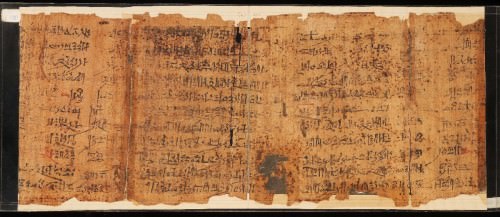
Ipuwer Papyrus
All of this makes it very tempting to link the Ipuwer Papyrus to a description of the First Intermediate Period - which is precisely what has been done - but there is really no reason for this. The Ipuwer Papyrus is literature, not history, and deals with a theme which was very popular in Egyptian writing, as scholar Miriam Lichtheim notes, that of "order vs. chaos" (150).According to Lichtheim, the Ipuwer Papyrus has nothing to do with the First Intermediate Period, and there are plenty of scholars who now agree with her. Still, owing to the lack of historical records from the time, and the similarity in social structure depicted (people of lower status now able to afford luxuries), many very fine scholars and historians have followed the lead of earlier writers in accepting Ipuwer's complaints as an accurate depiction of life during the First Intermediate Period. Even a historian of the stature of Margaret Bunson writes that the First Intermediate Period was "an age of turmoil and chaos that began with the collapse of the Old Kingdom" (78). That there was turmoil during the era is undeniable, but the 'chaos' so often referred to seems an exaggeration.
Further, the Ipuwer Papyrus has been linked to other periods and events as well, including the plagues from the biblical Book of Exodus, which the God of the Hebrews sends down upon Egypt. In the same way that Ipuwer has nothing to do with the First Intermediate Period, neither has it any historical light to shed on the biblical narrative. Narratives lamenting a time gone by, wishing for 'the good old days,' and complaining about the present state of one's life exist in every culture from ancient times to the present moment, and the Ipuwer Papyrus is one of many.
THE TWO KINGDOMS
The claim of turmoil and alleged chaos does have some historical support, however, and comes from the lack of a single strong central government and the division of rule between two kingdoms: Herakleopolis of Lower Egypt and Thebes of Upper Egypt. The 7th and 8th Dynasties of Egypt continued to rule from Memphis but, really, only had control over the local population. The various districts of the country were basically self-governing. The lack of knowledge of the kings of the 7th and 8th Dynasties is testimony to how ineffectual they were. Their names and dates have no lasting resonance in Egyptian history.At some point, the old capital at Memphis was abandoned by rulers there who saw themselves as successors of the Old Kingdom kings. These rulers of the 9th and 10th Dynasties (whose names and dates are so confused they barely make sense) then claimed the city of Herakleopolis as their capital and proclaimed themselves the true kings of Egypt. Siedlmayer writes:
We know very little about the eighteen or nineteen kings who made up Manetho's Herakliopolitan Dynasty, occupying the throne of Egypt for a period of perhaps 185 years. Even their names remain largely unknown, and, with only one or two exceptions, it is impossible to assign the few named kings to their correct places within the dynastic sequence. In addition, none of the lengths of their reigns is known. (Shaw, 128)
Whatever the rulers at Memphis were doing, and whatever their motivation in moving the capital to Herakleopolis, it was obviously ineffectual. The city of Thebes in Upper Egypt, which at the time of the move from Memphis to Herakleopolis was just another Egyptian nome among many, reacted to the power vacuum by moving to fill it.
THE RISE OF THEBES & REUNIFICATION
C. 2125 BCE a Theban nomarch named Intef, who carried the usual epithets of "great overlord" of the nome and "overseer of priests," rose in power at Thebes and challenged the authority of Herakliopolitan rulers. Intef I founded the 11th Dynasty of Egypt and began the impetus which would lead to the reunification of the country. He is later referenced in the time of the Middle Kingdom as "Intef the Great" and would have a statue raised to his memory in the Temple of Karnak. His enormous tomb of Saff el-Dawaba may still be seen today in the necropolis of el-Tarif near the ruins of Thebes.
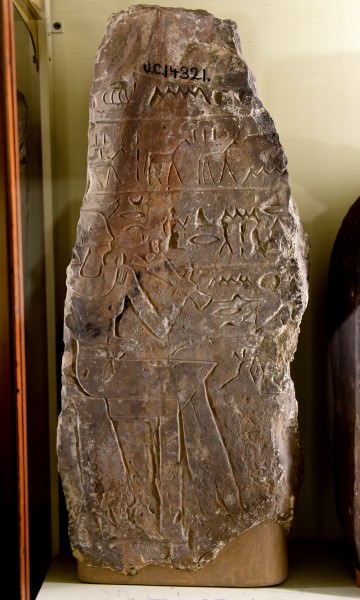
Egyptian stela from Intef blocks at a temple precinct
The second king of the 11th Dynasty, Menuhotep I (c. 2115 BCE) declared Thebes the true capital of Egypt and began the process of reunification by conquering neighboring nomes. This would continue through the reigns of the kings who followed him but especially by Wahankh Intef II (c. 2112-2063 BCE). Wahankh Intef II claimed the title of "King of Upper and Lower Egypt" and conquered the city of Abydos as one of his first acts. Abydos was one of the most ancient communities in Egypt where the early kings were buried, and in taking the city, Wahhankh Intef II was staking his claim as the rightful successor to these early rulers. With Abydos secured, he then waged war periodically with the rulers of Herakleopolis throughout his reign.
Wahankh Intef II was not merely a warlord or a provincial nomarch who had seized power. He considered himself a true king of Egypt and did his best to behave as one in keeping with the strictures and responsibilities of the past. He erected monuments and built temples to the gods, raising the first monument in honor of the god Amun at Karnak. He made sure his family, extended family, servants, and subjects were well cared for, and he maintained the principle of ma'at in his policies. In keeping with the paradigm of the best rulers of the Old Kingdom, Wahankh Intef II trusted only his closest family members and friends with power and delegated it sparingly. There were no powerful nomarchs in or around Thebes nor in any of the nomes taken under Theban rule. As Siedlmayer notes, Wahankh created a government which relied on "strong bonds of personal loyalty and on tight control" (Shaw, 126). This was precisely the policy of earlier kings such as Sneferu, Khufu, and Khafre of the Old Kingdom.
Upon his death, Wahankh Intef II was buried at el-Tarif outside Thebes with a biographical stele set up at the entrance.Siedlmayer writes:
This monument, which bears a depiction of the king accompanied by his favourite dogs, sums up in retrospect the accomplishments of his reign; and the statements made in the text are amply confirmed by the inscriptions of his followers. (Shaw, 125)
He was succeeded by Nakhtnebtepnefer Intef III (c. 2063 BCE), who captured Asyut from the Herakliopolitan kings and increased the reach of Thebes. His success was capitalized on by the great prince Mentuhotep II, who defeated Herakleopolis and united Egypt under his rule. Mentuhotep II was considered a 'second Menes' in later inscriptions and praised as the great king who had again brought order to the land. With Mentuhotep II's victory, the First Intermediate Period comes to a close and the period known as the Middle Kingdom begins. The developments of the First Intermediate Period would greatly influence the next era in Egypt's history. The rulers of the Middle Kingdom and the regional nomarchs would work together for most of the era to create some of the most impressive works of art and one of the most stable and affluent societies in history.
Amenhotep III › Who Was
Definition and Origins

Amenhotep III (c. 1386-1353 BCE) was the ninth king of the 18th dynasty of Egypt. He is also known as Nebma'atre, Amenophis III, Amunhotep II, and Amana-Hatpa, all of which relate to the concept of the god Amun being satisfied or, as in the case of Nebma'atre, with the ideal of satisfied balance. He was the son of the pharaoh Tuthmosis IV and his lesser wife Mutemwiya, husband of Queen Tiye, father of Akhenaten, and grandfather of Tutankhamun and Ankhsenamun. His greatest contribution to Egyptian culture was in maintaining peace and prosperity, which enabled him to devote his time to the arts. Many of the most impressive structures of ancient Egypt were built under his reign and, through military campaigns, he not only strengthened the borders of his land but expanded them. He ruled Egypt with Tiye for 38 years until his death and was succeeded by Amenhotep IV, later known as Akhenaten.
AMENHOTEP III'S OPULENT REIGN
Amenhotep's father, Tuthmosis IV, left his son an empire of immense size, wealth, and power. The Egyptologist Zahi Hawass writes, “Amenhotep III was born into a world where Egypt reigned supreme. Its coffers were filled with gold, and its vassals bowed down before the mighty rulers of the Two Lands [Egypt]” (27). He was only twelve years old when he came to the throne and married Tiye in a royal ceremony. It is a significant aspect of Amenhotep's relationship with his wife that, immediately after their marriage, she was elevated to the rank of Great Royal Wife, an honor which Amenhotep's mother, Mutemwiya, was never accorded and which effectively meant that Tiye outranked the king's mother in courtly matters.
AMENHOTEP III WAS A MASTER OF DIPLOMACY, SENDING LAVISH GIFTS OF GOLD TO OTHER NATIONS SO THEY WOULD BEND TO HIS WISHES, WHICH THEY INVARIABLY DID.
His marriage completed, the king set about continuing the policies of his father and implementing new building programs throughout Egypt. He was a master of diplomacy, who placed other nations in his debt through lavish gifts of gold so that they would be inclined to bend to his wishes, which they invariably did. His generosity to friendly kings was well established, and he enjoyed profitable relationships with the surrounding nations. He was also known as a great hunter and sportsman and boasted in an inscription that “the total number of lions killed by His Majesty with his own arrows, from the first to the tenth year [of his reign] was 102 wild lions” (Nardo, 19). Further, Amenhotep III was an adept military leader who “probably fought, or directed his military commanders, in one campaign in Nubia and he had inscriptions made to commemorate that expedition” (Bunson, 18). He maintained the honor of Egyptian women in refusing requests to send them as wives to foreign rulers, claiming that no daughter of Egypt had ever been sent to a foreign land and would not be sent under his reign. In all these ways, Amenhotep III emulated or improved upon his father's policies and in religion he did likewise. Amenhotep III was an ardent supporter of the ancient religion of Egypt and, in this, found a perfect outlet for his greatest interest: the arts and building projects.
MONUMENTAL CONSTRUCTIONS
The historian Durant describes the grandeur of Amenhotep's monuments in writing, “Two giants [sit] in stone, representing the most luxurious of Egypt's monarchs, Amenhotep III. Each is seventy feet high, weighs seven hundred tons, and is carved out of a single rock” (141). Amenhotep III's vision was of an Egypt so splendid that it would leave one in awe, and the over 250 buildings, temples, statuary, and stele he ordered constructed attest to his success in this. The statues which Durant mentions are today known as the Colossi of Memnon and are the only pieces left of Amenhotep III's mortuary temple. Their immense size and intricacy of detail, however, suggest that the temple itself – and his other building projects no longer extant – were equally or even more impressive.
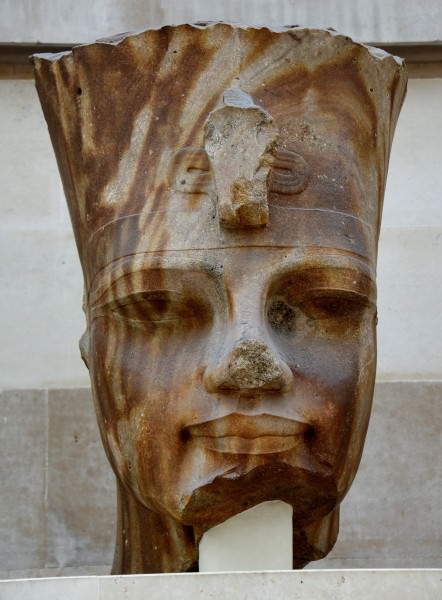
Pharaoh Amenhotep III
Among these projects was the new pleasure palace at Malkata, on the west bank of the Nile, just across from the capital of Thebes. Bunson writes that “the vast complex was called `The House of Nebma'atre as Aten's Splendour.' The resort boasted a lake over a mile long, which appears to have been created in only 15 days by advanced hydraulic sluicing techniques. The complex contained residences for the Queen Tiye and for Akhenaten, the king's son and heir. Amenhotep even had a pleasure bark, dedicated to the god Aten, built for outings on the lake” (18). He frequently took these outings in the company of Tiye and, it seems, she was often his closest companion in both public and private life. Tiye, in fact, operated on a nearly equal, or completely equal, status to her husband and is often depicted in statuary as the same height as he is, symbolizing the harmony and equality of their relationship. While Amenhotep was busy with his building projects, Tiye took care of the affairs of state and running the palace complex at Malkata.
That she was kept quite busy with these tasks is evident in letters from foreign rulers as well as the number of buildings constructed during Amenhotep III's reign. In addition to those already mentioned, he had 600 statues of the goddess Sekhmet erected around the Temple of Mut, south of Karnak, renovated the existing Temple at Karnak, built temples to Amun, erected statuary depicting Amun, raised stele which recorded his accomplishments, set the granite lions in front of the Temple of Soleb in Nubia, and decorated walls and monuments with scenes depicting his exploits and the pleasure the gods had in him. In his first year of rule, he had new limestone quarries dug in the region of Tura and, throughout his reign, he depleted them. Images of the pharaoh and his gods spread across the plains and valleys of Egypt and cities were refurbished. Roads were improved and travel became easier. The ease of travel helped merchants get their wares to market more quickly and this, of course, boosted the economy. With revenue already coming in from vassal states, Egypt became increasingly wealthy under Amenhotep III's reign. The populace was content and the power of the throne was stable except for the threat from the priests of the cult of the god Amun.
THE SUN GOD & THE PRIESTS OF AMUN
There was another power in Egypt which had been growing long before Amenhotep III came to the throne: the cult of Amun.Land ownership meant wealth in Egypt and, by Amenhotep III's time, the priests of Amun owned almost as much land as the king. In accordance with traditional religious practice, Amenhotep III did nothing to interfere with the work of the priests, but it is thought that their immense wealth, and threat to the power of the throne, had a profound effect on his son. The god Aten was only one of many gods worshipped in ancient Egypt but, for the royal family, he had a special significance which would later become manifest in the religious edicts of Akhenaten. At this time, however, the god was simply another worshipped alongside the rest.
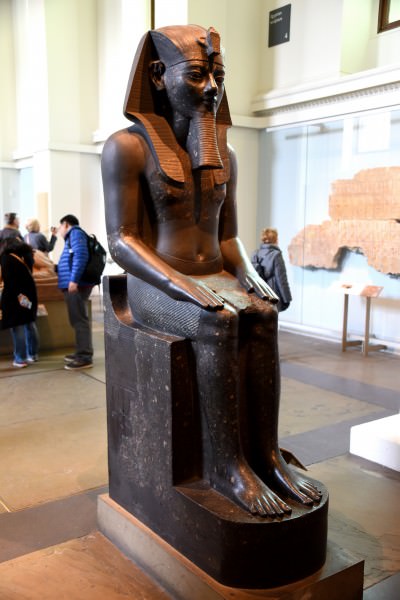
King Amenhotep III
Perhaps in an attempt to wrest some power from the priests of Amun, Amenhotep III identified himself with Aten more directly than any pharaoh had previously. Aten was a minor sun god, but Amenhotep III elevated him to the level of a personal deity of pharaoh. Hawass writes:
The sun god was a complex creature, whose dogma had been developing for thousands of years. In addition to his main incarnation as Re, this god was associated with the creator Atum as well as with deities such as Khepri…and Osiris, with whom Re merged at night. Another aspect of this god was the Aten; according to texts dating back at least to the Middle Kingdom, this was the disk of the sun, with which the king merged at death.This divine aspect, unusual in that it was not anthropomorphic, was chosen by Amenhotep III as a primary focus of his incarnation. It has been suggested that the rise of the Aten was linked specifically with maintenance of the empire, as the area over which, at least theoretically, the sun ruled. By associating himself with the visible disk of the sun, the king put himself symbolically over all the lands where it could be seen – all the known world, in fact (31).
Amenhotep III's elevation of Aten as his personal god was not uncommon. Pharaohs in the past were associated with a particular cult of a favored god and, obviously, Amenhotep III did not neglect the other gods in preference to Aten. If his goal in raising awareness of Aten was politically motivated, it did not accomplish very much at all during his reign. The cult of Amun continued to grow and amass wealth and, in doing so, continued to pose a threat to the royal family and the authority of the throne.
AMENHOTEP'S DEATH & THE REIGN OF AKHENATEN
Amenhotep III suffered from severe dental problems, arthritis, and possibly obesity in his final years. He wrote to Tushratta, the king of Mitanni (one of whose daughters, Tadukhepa, was among Amenhotep III's lesser wives) to send him the statue of Ishtar that had visited Egypt before, at his wedding to Tadukhepa, to heal him. Whether the statue was sent is a matter of controversy in the modern day and what, precisely, was ailing Amenhotep the III is likewise. It has been suggested that his dental problems resulted in an abscess which killed him but this has been disputed.
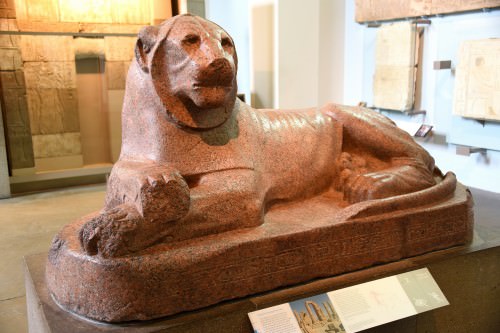
King Amenhotep III as a Lion
He died in 1353 BCE and letters from foreign rulers, such as Tushratta, express their grief on his passing and their condolences to Queen Tiye. These letters also make clear that these monarchs hoped to continue the same good relations with Egypt under the new king as they had with Amenhotep III. With Amenhotep III's passing, his son, then called Amenhotep IV, began his reign. At first, there was nothing which distinguished Amenhotep IV's rule from that of his father; temples were raised and monuments built just as before. In the fifth year of his reign, however, the new pharaoh underwent a religious conversion and outlawed the ancient religion of Egypt, closed the temples, and proscribed all religious practice. In place of the old faith, the king instituted a new one: Atenism. He changed his name to Akhenaten and created the first state mandated monotheistic system in the world.
Akhenaten continued to build monuments and temples just as his father had, but “these temples were not to Amun, but to the sun disk as the Aten” (Hawass, 36). The Aten was now the one true god of the universe and Akhenaten was the living embodiment of this god. The new king abandoned the palace at Thebes and built a new city, Akhetaten (`the horizon of Aten') on virgin land in the middle of Egypt. From his new palace he issued his royal decrees but seems to have spent most of his time on his religious reforms and neglected the affairs of state and, especially, foreign affairs. Vassal states, such as Byblos, were lost to Egypt, and the hopes which foreign rulers had expressed in continuing good relations with Egypt were disappointed.
Akhenaten's wife, Queen Nefertiti, assumed the responsibilities of her husband and, though she was adept at this, his neglect of his duties had already resulted in enormous loss of Egypt's wealth and prestige. During Akhenaten's reign, the treasury was slowly depleted, military discipline and efficacy was lax, and the people of Egypt, deprived of their traditional religious beliefs and the financial benefits associated with religious practices, suffered. Those who had once sold statuary or amulets or charms outside of temples no longer had a job, as the selling of such objects was illegal and those who worked in, or for, those temples were also unemployed. Foreign affairs were neglected as completely as the domestic and, by the time of Akhenaten's death in 1336 BCE, Egypt had fallen far from its height under the reign of Amenhotep III.
Akhenaten's son and successor, Tutankhamun, tried to reverse the fortunes of his country in the brief ten years of his reign but died at the age of 18 before he could accomplish his goals. He did, however, overturn his father's religious reforms, open the temples, and re-establish the old religion. His successor, Ay, continued these policies, but it would be Ay's successor, Horemheb, who would completely erase, or try to, the damage done to the country by Akhenaten's policies. Horemheb destroyed the city of Akhetaten, tore down the temples and monuments to Aten, and did this so thoroughly that later generations of Egyptians believed that he was the successor to Amenhotep III. Horemheb restored Egypt to the prosperity it had enjoyed before Akhenaten's reign, but Egypt never was able to manage the heights it had enjoyed under Amenhotep III, the luxurious pharaoh, diplomat, hunter, warrior, and great architect of Egyptian monuments.
LICENSE:
Article based on information obtained from these sources:with permission from the Website Ancient History Encyclopedia
Content is available under License Creative Commons: Attribution-NonCommercial-ShareAlike 3.0 Unported. CC-BY-NC-SA License